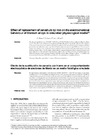Please use this identifier to cite or link to this item:
https://accedacris.ulpgc.es/jspui/handle/10553/47824
| Title: | Effect of replacement of vanadium by iron on the electrochemical behaviour of titanium alloys in simulated physiological media | Other Titles: | Efecto de la susti tución de vanadio por hierro en el compor tamiento electroquímico de aleciones de titanio en un medio fisiológico simulado | Authors: | Mareci, D. Lucero, V. Mirza Rosca, Julia Claudia |
UNESCO Clasification: | 330309 Operaciones electroquímicas 3312 Tecnología de materiales 3313 Tecnología e ingeniería mecánicas 331402 Prótesis |
Keywords: | Corrosion behavior Orthopedic implants Ti-6Al-4V Films Titanium, et al |
Issue Date: | 2009 | Publisher: | 0034-8570 | Journal: | Revista de Metalurgia | Abstract: | The electrochemical behaviour of Ti6A14V, TioA13.5Fe and Ti5A12.5Fe alloys has been evaluated in Ringer's solution at 25 °C. The effect of the substitution of vanadium in Ti6A14V alloy has been specifically addressed. The evaluation of the corrosion resistance was carried out through the analysis of the open circuit potential variation with time, potentiodynamic polarization curves, and electrochemical impedance spectroscopy (EIS) tests. Very low current densities were obtained (order of nA/cm2) from the polarization curves and EIS, indicating a typical passive behaviour for all investigated alloys. The EIS results exhibited relative capacitive behaviour (large corrosion resistance) with phase angle close to -80° and relative high impedance values (order of 105 Ω·cm2) at low and medium frequencies, which are indicative of the formation of a highly stable film on these alloys in Ringer's solution. In conclusion, the electrochemical behaviour of Ti6A14V is not affected by the substitution of vanadium with iron. El comportamiento electroquímico de las aleaciones Ti6Al4V, Ti6Al3.5Fe y Ti5Al2.5Fe fue evaluado en una disolución Ringer a 25 °C. Se ha estudiado especialmente el efecto de la sustitución del vanadio en la aleación Ti6Al4V. La evaluación de la resistencia a la corrosión se ha llevado a cabo a través del análisis de la variación del potencial de un circuito abierto con el tiempo, las curvas de polarización potenciodinámicas y los ensayos de espectroscopía de impedancia electroquímica (EIS). Se han obtenido densidades de corriente muy bajas (del orden de nA/cm2) en las curvas de polarización y EIS, indicando un comportamiento pasivo típico para todas las aleaciones investigadas. Los resultados de la EIS mostraron un comportamiento capacitivo relativo (gran resistencia a la corrosión) con ángulos de fase próximos a –80° y valores de impedancia relativamente altos (del orden de 105 Ω·cm2) a frecuencias bajas e intermedias, lo cual es indicativo de la formación de una película altamente estable sobre estas aleaciones en solución Ringer. En resumen, el comportamiento electroquímico de Ti6Al4V no se ve afectado si se sustituye el vanadio por el hierro. |
URI: | https://accedacris.ulpgc.es/handle/10553/47824 | ISSN: | 0034-8570 | DOI: | 10.3989/revmetalm.0750 | Source: | Revista de Metalurgia (Madrid) [ISSN 0034-8570], v. 45, p. 32-41 |
| Appears in Collections: | Artículos |
Citas SCOPUSTM
4
actualizado el 08-jun-2025
Citas de WEB OF SCIENCETM
Citations
3
actualizado el 08-jun-2025
Visitas
119
actualizado el 24-ago-2024
Descargas
39
actualizado el 24-ago-2024
Google ScholarTM
Verifica
Altmetric
Comparte
Exporta metadatos
Los elementos en ULPGC accedaCRIS están protegidos por derechos de autor con todos los derechos reservados, a menos que se indique lo contrario.
